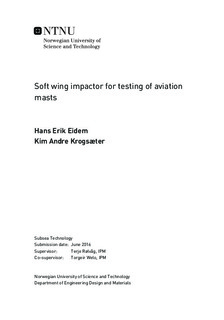Soft wing impactor for testing of aviation masts
Master thesis
Permanent lenke
http://hdl.handle.net/11250/2406358Utgivelsesdato
2016Metadata
Vis full innførselSamlinger
Sammendrag
Due to the imminent danger of colliding into aviation aids located with close proximity torunways or taxiways, ICAO was in the early 80 s specifically assigned to develop specificationsfor frangible lighting structures. As a result, the ICAO Frangible Aids Study Group (FASG)was established in 1981 to subsequently propose design specifications and crash test proceduresregarding frangibility of aviation aids and supporting masts. Two specific types of impactorswere used for testing and development of aviation lighting structures. These two types wererigid and soft impactors. However, during multiple tests conducted the last decades, the rigidimpactor was soon discovered to generate initial peak forces far above the limit of 45kN statedby ICAO FASG. It was also impossible to analyse structural damage since National AerospaceLaboratory (NLR), Netherlands, stated that the pass/fail criteria considering frangibility of anALS must be based on damage applied to the wing. Damage to the skin was accepted, butdamage to supporting wing-structures like the front spar was unacceptable. The rigid impactoris still used based on arguments such as inexpensiveness of production and the simple andreusable construction. However, FASG soon stated that only soft-impactors allowed for damageidentification and was therefore the correct choice during testing of aviation masts.In this master project, the assigned students have been tasked to document, benchmarkand qualify a standard Soft-Wing-Impactor (SWI) based on the proposed design by NLR. Intotal, four soft wing impactors are built and tested by conducting quasi-static compressionstests. The tests are conducted in accordance with the test procedure specified by NLR andsupervisor Rølvåg. The results from testing are compared to criteria specified by ICAO. Themain concern considering the validation of a SWI was that supporting aviation structures mustnot impose peak forces and energy to an aircraft wing higher than 45kN and 55kJ. Test resultsare also compared to a virtual test carried out by Rølvåg, and to physical compression testscarried out by Wiggenraad et.al. These are used as references in our discussions regarding thetest results.
Tensile and shear tests of the aluminum 2024-T3 and rivets were also conducted to verifymechanical properties. The results and results from the physical compression tests are intendedfor further calibration of the virtual model in Abaqus.
The results proved that the SWI s were sensitive to large shear-stress in the transitionbetween the skin and the tip of the nose-ribs. This happened to all SWI s since the test procedurespecified to place the intruder in between the two centre nose-ribs.
Test 1 and 2 yielded low peak forces due to rivets with low shear and tensile strength.The force reached 43 and 37kN before the main-spar was detached from the supporting ribstructure.Based on these results, test 3 and 4 were substituted with stronger rivets whichyielded sufficient shear and tensile strength based on tests carried out on the rivets. Test 3 and4 resulted in a peak force of 47 and 55kN. According to the ICAO limit of 45kN, these wereconsidered sufficient. Test 4 was the most reliable and sustainable impactor and can be used infuture tests of aviation masts based on the margin of 10kN.
